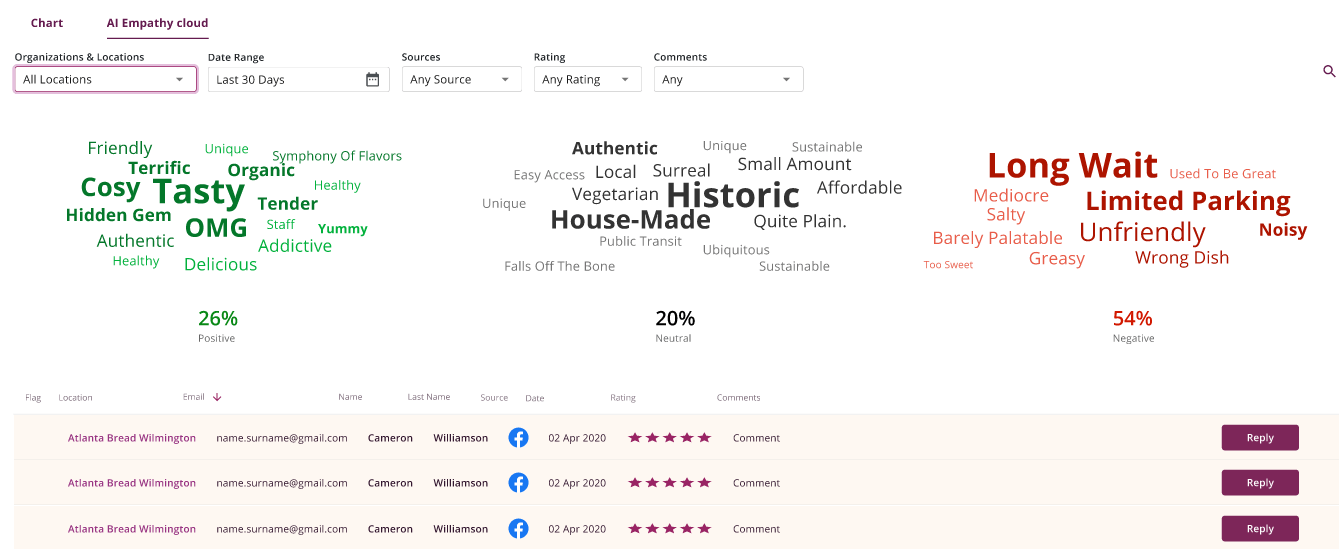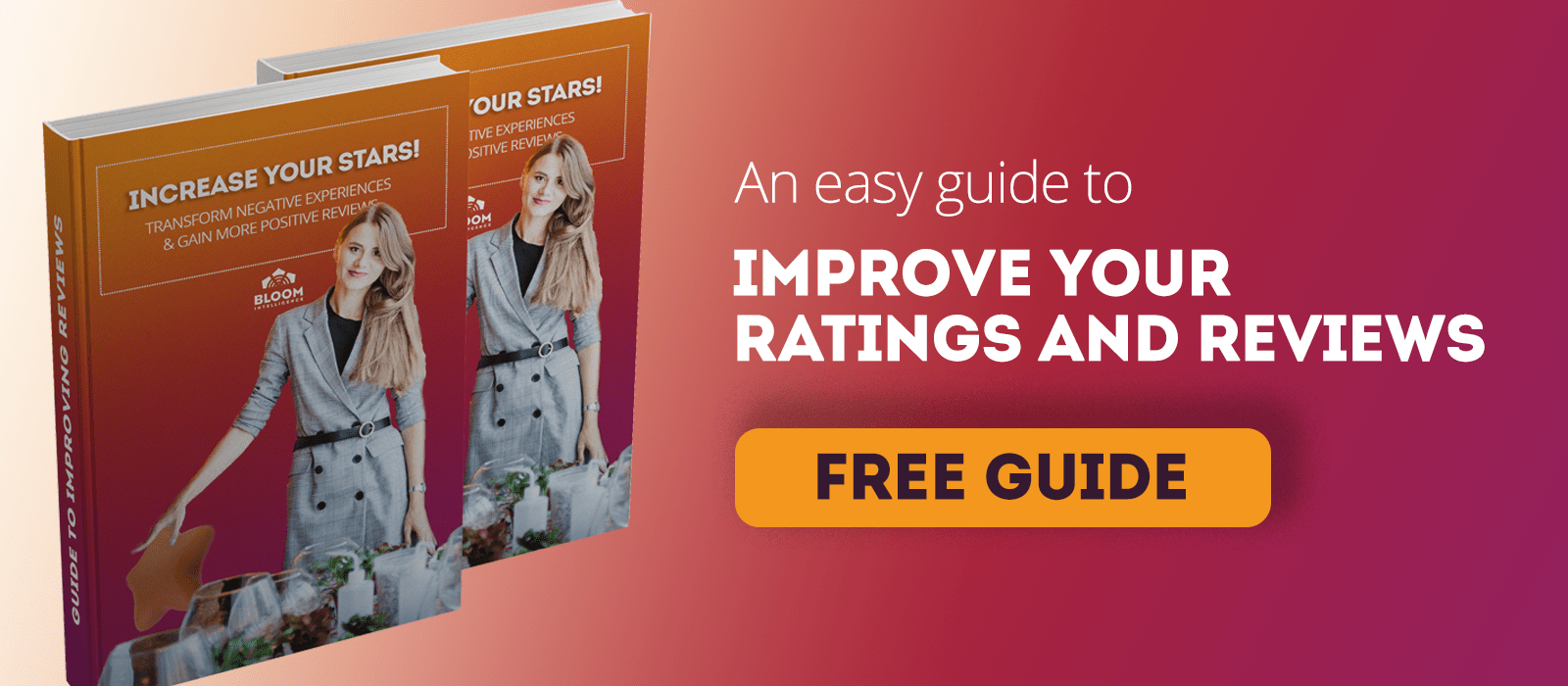Today’s restaurant industry is experiencing rising costs, labor worries, and falling consumer confidence. In uncertain times like these, it is important to keep guests happy and turn them into long-term regulars while doing so on a smaller, limited budget.
Providing a positive guest experience can be a smart way to drive revenue without draining your budget. A superior guest experience can drive revenue and loyalty even during tough economic times.
 According to American Express, 7 out of 10 U.S. consumers say they’ve spent more money to do business with a company that delivers a great experience.
According to American Express, 7 out of 10 U.S. consumers say they’ve spent more money to do business with a company that delivers a great experience.
Likewise, diners say that things like complimentary extras (69%) and seating preferences (65%) would go far in improving their experience and increasing their loyalty.
This is why having a solid understanding of customer sentiment is important for success. You can use it to both improve areas that need attention and reinforce those that guests really enjoy.
Customer sentiment is now such an important metric that about two-thirds (64%) of companies consider customer sentiment analysis key to measuring guest engagement, and nearly half (49%) say tracking sentiment trends is a key benefit they can take advantage of.
Customer sentiment analysis is a powerful way to gain insight into the thoughts and feelings of your guests. By understanding how your restaurant is perceived by guests and online orderers you can make adjustments to improve, and also find out what aspects are most valued.
The key to discovering and analyzing true customer sentiment is to fully understand your guests by collecting data from a number of different channels.
Here we will learn more about the different ways restaurants can use sentiment analysis, such as analyzing online ratings and reviews, to see if they are meeting guests’ needs.
Of course, talking to your guests is a great way to discover their sentiment, and should be one of the goals of every restaurant owner. Keeping detailed and consistent notes is key to making this strategy work.
Unfortunately, many owners and operators simply do not have the time to speak to every guest table at every service.
This is where technology can help you understand actual guest behavior and sentiment, saving you valuable time so you can concentrate on running your shift while providing the best guest experience possible.

Aggregating Guest Data for Customer Sentiment Analysis
A restaurant customer data platform (CDP) is a tool that collects and aggregates guest data from many different sources. It will aggregate the data into a single platform to easily gain rich guest insights into their behavior and how they feel about your restaurant.
Here are some useful ways to use this technology to discover guest sentiment and improve your business.
Online Ordering Data
Online ordering has become much more popular with diners in the last few years. Since the pandemic began, online ordering has skyrocketed as a major part of restaurant revenue all over the world.
Why not use this channel to help discover the guest experience?
By integrating your online ordering system with your restaurant customer data platform, you can collect data from each and every guest who orders online. The data will include their contact information and their complete ordering history.
With a unified wifi marketing platform, you can send an automated message to guests who order online and ask them how their ordering experience was. Or, you could inquire about the quality of the delivered order. This is also known as online ordering marketing.
Best of all, it is completely automated to save you time. All you have to do is monitor the results and make data-driven changes based on them.

Using Review Sites to Measure Customer Sentiment
Not only are positive ratings and reviews good for a restaurant’s bottom line, but they are also great for spotting trends and measuring customer sentiment.
They can give you very deep insights into your customer base. They tell you not only what your guests like and dislike, but the reasoning behind the way they feel that way.
This provides actionable insight to help you improve the overall guest experience, manage complaints better, spot trends, and spot new opportunities — all of which can increase brand loyalty and repeat customers.
For example, you may discover consistent negative reviews about a certain menu item being too salty or not large enough in portion size – so you change the recipe and increase portion size. This is a great example of being able to make positive changes based on customer sentiment.
It is valuable unsolicited feedback at no cost.
To get the most out of your data, you need to be able to focus on the big picture while also looking at specific details. In using sentiment analysis, customer feedback becomes clear and useful information that can help you make targeted changes to improve your overall guest experience.
By aggregating the reviews into your CDP from sites like Google and Facebook, you can read, manage, and respond to all reviews in one centralized platform.
Moreover, the platform will analyze your ratings and provide you with an AI-driven word cloud to show a graphical image of positive, neutral, and negative words and phrases from all of your reviews on online review websites.

In this image, you can easily see what guests like about the place of business, and what could use improvement. For instance, using the example above, you can see that guests enjoy the food, but are frequently upset by limited parking and long wait times.
It is also very important that you respond to your reviews – both good and bad – to help build even more positive customer sentiment. This will inherently improve your ratings over time.
A study performed by Michael Anderson and Jeremy Magruder, professors at the University of California, Berkeley, concluded that positive reviews have a direct correlation to increases in foot traffic during peak times.
They found that a ½-star rating increase resulted in a 30-40 percent increase in the number of 7 pm bookings.
Based on this study, although online rating websites may not generate attributable financial returns, they can certainly play a role in your restaurant’s success, driving more foot traffic and overall revenue.
At your next peak service time, think about what a 30-40 percent increase in bookings would look like at your restaurant.
Positive Customer Ratings Increase Revenue
Another study conducted by Professor Michael Luca at the Harvard Business School sought a correlation between online ratings and actual revenue.
The study found that a rating improvement of one star led to an increase in revenue of between 5 and 9 percent.
Interestingly, Luca also found that the star rating of restaurants played a much higher role in consumer decision-making, finding that website visitors were often overwhelmed by the number of written reviews.
Luca concluded, “Online consumer review websites improve the information available about product quality. The impact of this information is larger for products of relatively unknown quality…On the consumer side, simplifying heuristics and signals of reviewer quality seem to increase the impact of quality information.”
If a review is great, thank the reviewer and tell them you hope to see them again soon. If the review is positive, but not glowing, try to see if you can spot something that would have made their experience better.
Responding to negative reviews is also very important. Your response to a negative review can actually influence and impress potential future customers. Make sure to respond in a positive tone and provide an effective solution to the issues that caused the negativity.
This shows that you are actively listening to your guests and that you commit yourself and your restaurant to making things better. Make sure and take action to resolve the issue.
These are just a few examples of using customer reviews to make your customer experience and sentiment better – the options are endless.
By monitoring and evaluating customer sentiment, and then taking action based on it, you can keep your restaurant top-of-mind of your local consumers.
Discover the Bloom Intelligence Customer Data Platform
It’s time to start planning for the successful future of your restaurant. And ensuring a positive guest experience is the secret.
Using Bloom’s restaurant marketing and customer data platform, you can collect data from many different sources. Then you can leverage the real-time guest insights and campaign reporting to not only get lost guests back through your door but also to attract new guests and keep them coming back.
Don’t let your guests get away because of a bad experience. In a rough economy with rising food and labor costs, guest acquisition and retention are crucial for success.
If you’d like to see the Bloom restaurant customer data platform in action, and discover how you can grow your business through guest intelligence and marketing automation, schedule a free demo or call 727-877-8181.






.svg)